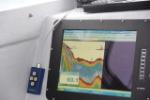Dr. Mark Abrahams
Professor
Department of Biology / Ocean Sciences Memorial University of Newfoundland, Canada, A1C 5S7
email mabrahams@mun.ca
Research
My research program focuses primarily on fish and examines interactions between predators and their prey and the impact this has on the ecosystem. Research in my laboratory includes a computer models, laboratory experiments and field research.
Examples of research conducted in the laboratory include:
1. The impact of the physical environment
 For a fish to be a predator of another fish, it must usually be considerably larger than its prey. Due to this dramatic size difference, there is often also a significant difference in their physiological response and tolerance to the physical environment. Such differences include variation in their ability to withstand different levels of dissolved oxygen, as well as responses to turbidity and temperature. Building upon this work I am now seeking to determine their ramifications on overall habitat quality and their impact on ecosystem function.
For a fish to be a predator of another fish, it must usually be considerably larger than its prey. Due to this dramatic size difference, there is often also a significant difference in their physiological response and tolerance to the physical environment. Such differences include variation in their ability to withstand different levels of dissolved oxygen, as well as responses to turbidity and temperature. Building upon this work I am now seeking to determine their ramifications on overall habitat quality and their impact on ecosystem function.
2. The environmental impact of predictability
 Within marine ecosystems predictability is related to scale. This means it is easier to predict what will happen at very large spatial and temporal scales than at small scales. An exception to this rule is man-made structures such as sewage outflows and sea cage aquaculture sites. They have a fixed spatial location and provide resources on a regular temporal scale – effectively a predictable oasis within a stochastic sea. Through hydroacoustic surveys we have previously demonstrated that such sites can dramatically increase the abundance of marine life over a number of kilometers and well beyond the specific location of the predictable site. We are now conducting working to understand the ecological mechanisms responsible for this phenomenon.
Within marine ecosystems predictability is related to scale. This means it is easier to predict what will happen at very large spatial and temporal scales than at small scales. An exception to this rule is man-made structures such as sewage outflows and sea cage aquaculture sites. They have a fixed spatial location and provide resources on a regular temporal scale – effectively a predictable oasis within a stochastic sea. Through hydroacoustic surveys we have previously demonstrated that such sites can dramatically increase the abundance of marine life over a number of kilometers and well beyond the specific location of the predictable site. We are now conducting working to understand the ecological mechanisms responsible for this phenomenon.
3. Sensory physiology and invasion biology
 Most fish employ a variety of senses to obtain information from their environment. However, the effectiveness of these senses varies depending upon the characteristics of the physical environment. We are now studying the morphology of fish brains to identify how different species and populations invest in different forms of information. We also want to understand how their competitive abilities are affected by changes in the environment and whether the combined effects of anthropogenic change in the environment and sensory physiology can identify which species might be vulnerable to displacement through invasion.
Most fish employ a variety of senses to obtain information from their environment. However, the effectiveness of these senses varies depending upon the characteristics of the physical environment. We are now studying the morphology of fish brains to identify how different species and populations invest in different forms of information. We also want to understand how their competitive abilities are affected by changes in the environment and whether the combined effects of anthropogenic change in the environment and sensory physiology can identify which species might be vulnerable to displacement through invasion.